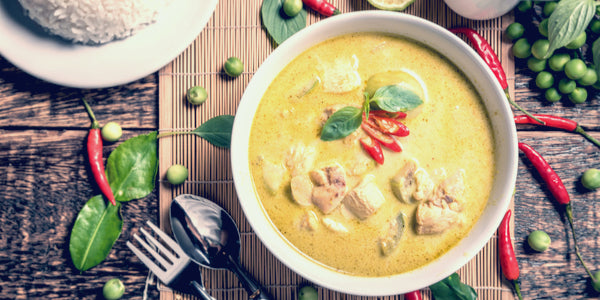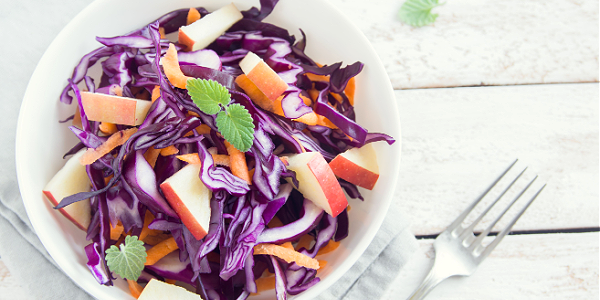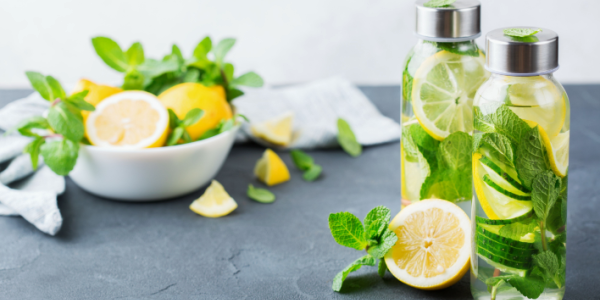
Slightly sweet, slightly spicy, ultimately packed with flavor! One unique combination of ingredients that is green curry.
Find out how we made a classic dish into one healthy and tasty recipe that is sure to top your favorite list.
We also share 10 pro chef recipe notes to prepare the ultimate recipe that bursts with flavor. But more on that later!
Without further ado, one delicious Thai green curry recipe you do not want to miss!
Thai Green Curry Recipe
Yield: 6 servings
Nutrition per serving: 340 calories, 13 g fat, 20 g protein, 32 g total carb, 4 g fiber
Prep time: 15 minutes
Cook time: 30 minutes
Total time: 45 minutes
Ingredients:
• 1 3/4 cups water, plus more if necessary
• 1 cup jasmine rice, rinsed
• 3/4 tsp salt
• 2 Tbsp Thai green curry paste
• 2 large garlic cloves, minced
• 1 Tbsp fresh ginger (about 1-inch nub of ginger), finely grated
• 1 Tbsp lemongrass paste or fresh lemongrass, finely chopped (see note 4)
• 1/2 cup chicken broth, low-sodium
• 1, 14-ounce can full-fat coconut milk
• 6 kaffir lime leaves
• 1 1/2 tsp coconut sugar
• 2 tsp fish sauce, plus more to taste
• 1 lb chicken thighs, cut into 1/3-inch-thick slices
• 2 Japanese eggplants, chopped in bite-sized pieces
• 1 1/2 cup snow peas or sugar snap peas
• 12 Thai basil leaves, sliced into thin shreds
• Fresh lime juice and lime zest from ½ lime
• 1 Tbsp tamari
• 2 tsp rice vinegar or fresh lime juice
• Handful cilantro, chopped (optional)
• Sprinkle of crushed red pepper flakes (optional)
Instructions:
1. To cook the rice, bring the water to a boil in a medium saucepan over medium-high heat. Stir in the rice and salt, reduce the heat to low, and simmer for 15 minutes or until the water is absorbed. Cover, remove from heat and allow to rest for 10 minutes or longer, until ready to serve. Just before serving, fluff it with a fork.
2. While the rice is cooking, begin curry by heating a large skillet with deep sides over medium heat. Once hot, add the curry paste, garlic, ginger, and lemongrass and cook until fragrant, about 2 minutes.
3. Add chicken broth and stir to dissolve the paste. Slowly simmer until liquid reduces by about half.
4. Add the coconut milk, kaffir lime leaves, coconut sugar, and fish sauce and stir well.
5. Add chicken. Bring to simmer, then turn the heat down to medium. Simmer for about 15 minutes or until chicken is cooked through.
6. Add eggplant and cook until soft, about 5 minutes. Add snow peas and cook for an additional 2 minutes, or until a touch softened. The sauce should have reduced but will still be on the thin side, not thick.
7. Remove the pot from the heat. Stir in the Thai basil and lime juice and season with tamari and rice vinegar. If the curry needs a little more punch, add 1/2 teaspoon more tamari or 1/2 teaspoon more rice vinegar for more acidity.
8. Divide rice and curry into bowls and garnish with chopped cilantro and a sprinkle of red pepper flakes, if you’d like.
10 Chef Recipe Notes for Thai Green Curry
Elevate the next bowl of curry with these chef recipe notes, featuring ingredient tips and tricks for simple prep.
1. Green Thai Curry Paste
New to purchasing curry paste? Look for it in the Asian section of the grocery store. Start with using 2 tablespoons if unsure about the spice level – you can always add more!
2. Coconut Milk
Use regular, not light or reduced-fat, coconut milk that contains guar gum for a creamy, full-bodied texture. Varieties without guar gum are not nearly as creamy, even though their fat content is the same.
3. Coconut Sugar
Coconut sugar is a common ingredient in Thai. Use other sugar varieties, including palm sugar, brown sugar, and turbinado sugar, as desired.
4. Lemongrass Paste
Tubes of cold-pressed lemongrass paste are convenient. Substitute 2 teaspoons of finely minced fresh lemongrass as needed.
5. Kaffir Lime Leaves
Kaffir lime leaves are the leaves of a kaffir lime tree and used to add earthy, citrus flavors into Asian cuisine. While dried is a viable substitute, try finding fresh in the Asian section for a topnotch restaurant-quality dish.
6. Chicken
Thigh is best for this green curry chicken because it's nice and juicy being dark meat. But chicken breast is also fine, as it is packed with protein and lower in fat. Omit for a vegetarian option.
7. Thai Basil
Thai basil looks like normal basil but has pointier leaves and a purplish tinge. It tastes like a combination of basil and aniseed. Ordinary basil is an adequate substituted, but only use a small handful.
8. Japanese Eggplants
Japanese eggplants are shaped like a cucumber and act as sponges to soak up the curry sauce. Sub with small eggplants as desired, but keeping the skin on so the pieces do not get overly soft.
9. Tamari
Tamari is a popular sauce used in Japanese cuisine. It tastes similar to soy sauce but offers a richer, more savory flavor.
Prepared with soybeans, tamari is often considered to be a gluten-free option. But always verify whether or not wheat has been added and it is certified gluten-free.
10. Other Vegetables
The curry recipe is already packed with flavor and nutrients. But feel free to stuff with other veggies and ingredients, including:
• Asparagus
• Baby spinach leaves
• Bell peppers
• Bamboo shoots
• Cauliflower
• Green beans
• Potatoes
• Tomatoes
There are no hard and fast rules about what goes into a Thai green curry or stir fry, so have some creative fun!







